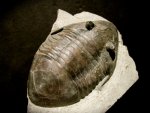Trilobita : Asaphida
 The trilobites of order Asaphida are notably diverse in number of species and morphology, and interestingly contains about 20% of known species. The most differentating morphological feature of the Asaphid trilobites is the smooth and isopygous similar in size) cephalon and pygidium, an evolutionary adaptation called effacement believed to have helped trilobites more easily burrow into and hide in sediment. Another theory is that the smoothing of the exoskeleton streamlined the trilobite for locamotion. Effacement is also evident among the Agnostids, and Suborder Illaenina of Order Corynexochida. The Asaphids appeared in the Middle Cambrian and persisted to the Lower Silurian. Order Asaphida comprises six Superfamilies: Anomocaroidea; Asaphoidea; Cyclopygoidea; Trinucleioidea; Dikelokephaloidea; and Remopleuridoidea listed at the bottom of this page. .
The trilobites of order Asaphida are notably diverse in number of species and morphology, and interestingly contains about 20% of known species. The most differentating morphological feature of the Asaphid trilobites is the smooth and isopygous similar in size) cephalon and pygidium, an evolutionary adaptation called effacement believed to have helped trilobites more easily burrow into and hide in sediment. Another theory is that the smoothing of the exoskeleton streamlined the trilobite for locamotion. Effacement is also evident among the Agnostids, and Suborder Illaenina of Order Corynexochida. The Asaphids appeared in the Middle Cambrian and persisted to the Lower Silurian. Order Asaphida comprises six Superfamilies: Anomocaroidea; Asaphoidea; Cyclopygoidea; Trinucleioidea; Dikelokephaloidea; and Remopleuridoidea listed at the bottom of this page. .
The major extinction event concluding the Ordovician Period markedly reduced trilobite diversity across all the orders. Among the Asaphids, only some members of superfamily Trinucleioidea survived, and they too met extinction near the end of the Silurian.
 The trilobites of order Asaphida are notably diverse in number of species and morphology, and interestingly contains about 20% of known species. The most differentating morphological feature of the Asaphid trilobites is the smooth and isopygous similar in size) cephalon and pygidium, an evolutionary adaptation called effacement believed to have helped trilobites more easily burrow into and hide in sediment. Another theory is that the smoothing of the exoskeleton streamlined the trilobite for locamotion. Effacement is also evident among the Agnostids, and Suborder Illaenina of Order Corynexochida. The Asaphids appeared in the Middle Cambrian and persisted to the Lower Silurian. Order Asaphida comprises six Superfamilies: Anomocaroidea; Asaphoidea; Cyclopygoidea; Trinucleioidea; Dikelokephaloidea; and Remopleuridoidea listed at the bottom of this page. .
The trilobites of order Asaphida are notably diverse in number of species and morphology, and interestingly contains about 20% of known species. The most differentating morphological feature of the Asaphid trilobites is the smooth and isopygous similar in size) cephalon and pygidium, an evolutionary adaptation called effacement believed to have helped trilobites more easily burrow into and hide in sediment. Another theory is that the smoothing of the exoskeleton streamlined the trilobite for locamotion. Effacement is also evident among the Agnostids, and Suborder Illaenina of Order Corynexochida. The Asaphids appeared in the Middle Cambrian and persisted to the Lower Silurian. Order Asaphida comprises six Superfamilies: Anomocaroidea; Asaphoidea; Cyclopygoidea; Trinucleioidea; Dikelokephaloidea; and Remopleuridoidea listed at the bottom of this page. .